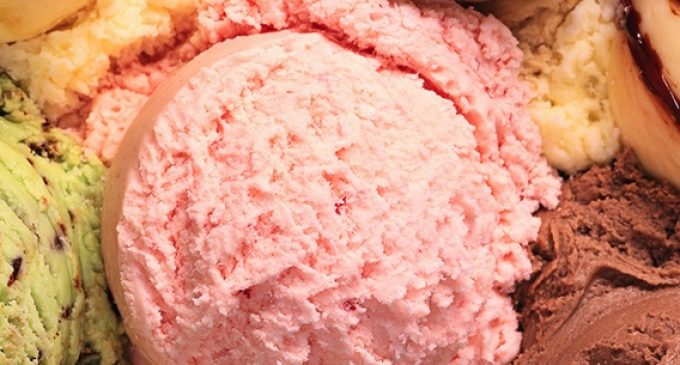Chocolate Flavour Scoops Top Spot in UK Ice Cream Innovation

New research from Mintel reveals that there were more chocolate flavoured ice cream products launched in the UK in the past year than vanilla for the first time in eight years. According to Mintel’s Global New Products Database (GNPD) as many as 22% of all new ice cream products launched in the UK in the past 12 months were chocolate flavoured, compared to vanilla at 18%, caramel or caramelised flavours at 13% and strawberry at 12%.
While chocolate is top of the ice cream flavours this year, since 2007/2008 vanilla has been the number one flavour in innovation. After peaking in popularity in 2013/14, when as many as 34% of all products were vanilla flavoured, the popularity of vanilla has been declining steadily with less than one in five (18%) new products launched with a vanilla flavour in 2015/16. Meanwhile, the popularity of chocolate as a flavour in new product development has been rising steadily over the past three years increasing from just 15% of all UK new ice cream products in 2013/2014 to a sublime 22% in 2015/2016.
But it’s not just chocolate that is stirring innovators, as Brits are also sweet on caramel and caramelised flavours. Indeed, the number of new ice cream products with a caramel or caramelised flavour has risen from 6% of all UK new ice cream products in 2011/2012, doubling to a delicious 13% in 2015/16.
 Alex Beckett, Global Food and Drink Analyst at Mintel, comments: “The ongoing popularity of ice cream bars is inspiring ice cream innovators, prompting the rise in chocolate flavours. Also, while health is a booming innovation trend in ice cream, with dairy- and sugar-free launches taking up more freezer space, some brands are going the opposite route and ramping up the indulgent factor. Hence more chocolate and caramel. This is further proof that British ice cream trends eventually emulate those of the US, where chocolate has been the top ice cream launch flavour for years.”
Alex Beckett, Global Food and Drink Analyst at Mintel, comments: “The ongoing popularity of ice cream bars is inspiring ice cream innovators, prompting the rise in chocolate flavours. Also, while health is a booming innovation trend in ice cream, with dairy- and sugar-free launches taking up more freezer space, some brands are going the opposite route and ramping up the indulgent factor. Hence more chocolate and caramel. This is further proof that British ice cream trends eventually emulate those of the US, where chocolate has been the top ice cream launch flavour for years.”
Although chocolate has become prevalent in ice cream, it appears that Brits still want to see more of it – especially the posher stuff. Half (48%) of all Brits are interested in seeing a wide variety of ice cream made with high-quality chocolate from premium chocolatiers and cocoa from a specific region, with the popularity of premium quality products peaking among 16-24 year olds (57%).
 When it comes to who screams for ice cream, it seems it’s the UK’s young men who are the biggest fans of this frozen treat. Almost three in five (58%) UK men aged 16-24 say they typically eat ice cream once a week or more in the spring and summer months, compared to just 46% of women aged 16-24.
When it comes to who screams for ice cream, it seems it’s the UK’s young men who are the biggest fans of this frozen treat. Almost three in five (58%) UK men aged 16-24 say they typically eat ice cream once a week or more in the spring and summer months, compared to just 46% of women aged 16-24.
Overall, Mintel research reveals that most Brits are hot for ice cream as just 5% of UK consumers say they don’t typically eat ice cream in the spring and summer months and less than one in five (17%) say they don’t tend to eat the treat in autumn and winter. As a result of their hunger for ice cream, UK consumers are predicted to purchase 337 million litres of the treat in 2016 from retail channels, well over that of Italian consumers who are forecast to scoop up just 284 million litres.
As well as appealing to a nation of chocolate lovers, introducing a hot element to ice cream could help to overcome any aversion to cold food in colder weather. Two in five (41%) UK consumers have expressed an interest in ice cream that comes with a sauce to be heated.
“The ice cream market is notoriously weather dependent and, accordingly, seasonal, with usage dropping during lacklustre summers and in the colder autumn and winter months. Ice cream that comes with a separate sauce to be heated attracts considerable interest among users, potentially offering a means of boosting sales in the chillier months,” Alex Beckett adds.
 Finally, Mintel research reveals the popularity gelato enjoys in the US is now making its way across Europe. Having long been a favourite in parlours and scoop shops, gelato has now become much easier to find in US retailers over the past couple of years with as many as 43% of US consumers buying gelato. Consumption of gelato in Europe remains relatively low with under three in 10 German (29%) and Spanish (27%) consumers eating gelato in 2015, falling to fewer than one in five (19%) French consumers. However, Mintel research indicates that the popularity of gelato is spreading globally, and there is strong demand in European markets for gelato to be made more widely available at retail. Mintel GNPD shows a 95% increase in global gelato introductions over the past 5 years. Meanwhile, one in five (20%) Brits believe gelato tastes better than other ice cream, peaking at 31% of 16-24s.
Finally, Mintel research reveals the popularity gelato enjoys in the US is now making its way across Europe. Having long been a favourite in parlours and scoop shops, gelato has now become much easier to find in US retailers over the past couple of years with as many as 43% of US consumers buying gelato. Consumption of gelato in Europe remains relatively low with under three in 10 German (29%) and Spanish (27%) consumers eating gelato in 2015, falling to fewer than one in five (19%) French consumers. However, Mintel research indicates that the popularity of gelato is spreading globally, and there is strong demand in European markets for gelato to be made more widely available at retail. Mintel GNPD shows a 95% increase in global gelato introductions over the past 5 years. Meanwhile, one in five (20%) Brits believe gelato tastes better than other ice cream, peaking at 31% of 16-24s.
Although it’s widely found in high street gelaterias, in Italy, half (49%) of consumers want to see more gelato in stores. For gelato makers, France also offers huge sales potential as, despite low consumption, French consumers are keen to see more of it: two in five (41%) French ice cream consumers would like to see more gelato available in supermarkets, and 46% of under-34s want to see a wider choice of gelatos in retail.
“While the rest of the world is taking longer to develop a taste for gelato, there are signs that it could one day boast a global appeal as consumer tastes are becoming more sophisticated. In the UK, consumer appetite for gelato has grown in line with increased new product development activity in supermarkets. A number of supermarkets now have a private label gelato range, and branded offerings are slowly emerging. Gelato is well-placed to continue benefiting from a consumer mind-set that reasons ‘If I’m going to buy ice cream, I want the good stuff’,” Alex Beckett concludes.

































